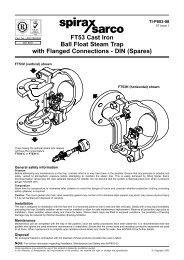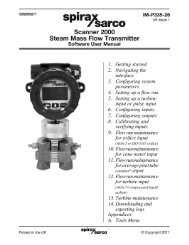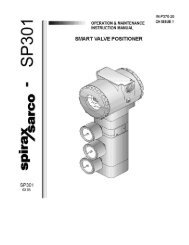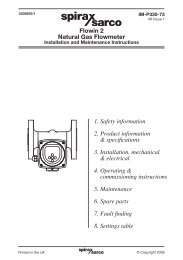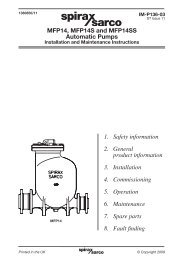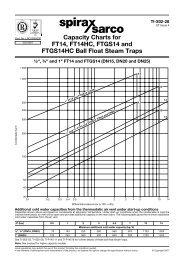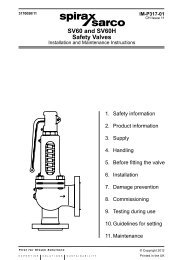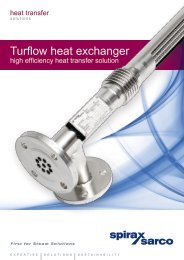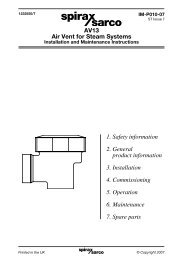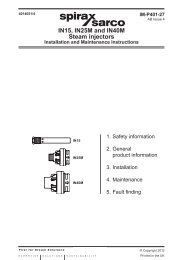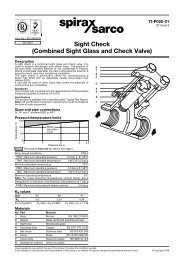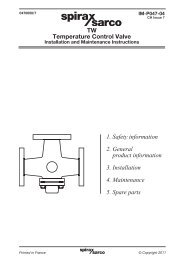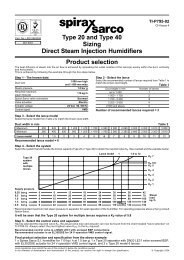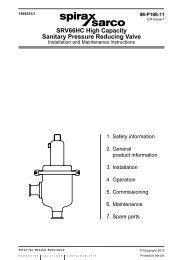Scanner 2000 Steam Mass Flow Transmitter ... - Spirax Sarco
Scanner 2000 Steam Mass Flow Transmitter ... - Spirax Sarco
Scanner 2000 Steam Mass Flow Transmitter ... - Spirax Sarco
Create successful ePaper yourself
Turn your PDF publications into a flip-book with our unique Google optimized e-Paper software.
<strong>Scanner</strong> ® <strong>2000</strong> microEFM Section 2<br />
1. Verify that the meter is properly installed in the flow line (per manufacturer’s instructions).<br />
2. Mount the <strong>Scanner</strong> <strong>2000</strong> to a 2-in. pipe or to a flat, vertical surface using bolts and the mounting holes in<br />
the enclosure. A horizontal pipe is recommended, as additional hardware may be required for a vertical<br />
pipe mount to provide clearance for the manifold block.<br />
3. Install tubing and fittings to connect the high-pressure and low-pressure taps of the DP meter to the process<br />
connections of the block manifold. Install a pair of shut-off valves near the high and low ports of the<br />
DP meter. Use a suitable compound or tape on all threaded process connections.<br />
4. Route any additional inputs/outputs or COM connections, etc. through the conduit opening in the top of<br />
the <strong>Scanner</strong> <strong>2000</strong>. In hazardous environments, add a conduit seal within 18 in. of the <strong>Scanner</strong> <strong>2000</strong>.<br />
Note To prevent fittings from turning and/or to avoid putting tension on stainless steel tubing, use a backup<br />
wrench to attach stainless steel tubing to shut-off valves, or sensor ports.<br />
5. To eliminate air bubbles in the MVT, manifold, and legs connecting them to the meter, fill the legs with<br />
fluid. Choose a fluid that is safe for the environment, and stable when depressurized.<br />
Important If the process fluid does not present an environmental risk and is stable when depressurized,<br />
it may be used to bleed air from the lines. If the process fluid can contaminate the<br />
environment, or is highly volatile when depressurized as with liquified gases, a different<br />
seal fluid should be used to fill the legs. An ideal seal fluid is one that does not dissolve<br />
in the process fluid.<br />
Bleeding with Process Fluid<br />
a. Make sure the shut-off valves in the tubing near the meter pressure taps are closed, and the meter is<br />
filled with process fluid.<br />
b. Open the equalizer and bypass/block valves on the block manifold. Make sure the vent valve is<br />
closed.<br />
c. Open one of the shut-off valves near the meter.<br />
d. Slowly loosen the corresponding vent screw on the MVT, and throttle the rate of flow from the vent<br />
with the shut-off valve.<br />
e. When air bubbles are no longer visible around the MVT vent, tighten the MVT vent screw.<br />
f. Repeat steps a through e for the other leg.<br />
Bleeding with a Different Seal Fluid<br />
a. Make sure the shut-off valves in the tubing near the pressure taps are open.<br />
b. Open the equalizer and bypass/block valves on the block manifold. Make sure the vent valve is<br />
closed.<br />
c. Remove the vent screw from one side of the MVT and insert a fitting to allow connection of a hand<br />
pump or funnel. If a funnel is used, attach a length of Tygon tubing that is long enough to elevate the<br />
funnel well above the meter pressure taps to force the fluid up the legs.<br />
47



